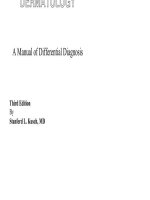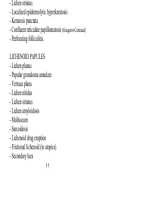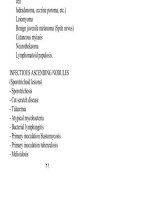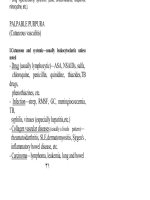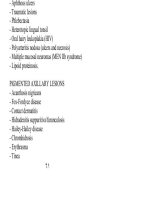Ebook Easy ECG: Interpretation - Differential diagnosis: Part 2
Bạn đang xem bản rút gọn của tài liệu. Xem và tải ngay bản đầy đủ của tài liệu tại đây (11.26 MB, 44 trang )
97
4
Coronary Heart Disease
and Myocardial Infarction
98
4
Coronary Heart Disease and Myocardial Infarction
Right and Left Coronary Arteries
1
2
3
6
4
5
7
8
9
Right coronary artery (RCA) [1]:
Supply:
Parts of the lateral and posterior wall, atria, sinus and AV node
Branches:
– Before crux cordis:
• Atrial branches: right atrial branches [2]
• Right ventricular branches [3]
• Marginal branches [4]
Division at the crux cordis:
• Posterior interventricular branch [5]
• Posterior lateral branches (one to three branches) [6]
Left coronary artery (LCA, main branch) [7]:
Supply:
Of the anterolateral anterior wall, of the ventral and apical septum,
parts of the lateral and posterior wall, atria, sinus and AV node
Branches:
– To the anterior wall: left anterior descending artery (LAD) [8]
– To the lateral wall: circumflex branch (RCX ) [9]
Left Anterior Descending Artery and Circumflex Artery
1
3
Left anterior descending artery (LAD) [1]:
Supply:
Of the anterolateral wall, of the ventral and apical
septum
Branches:
– To the septum: septal branches [2]
– To the anterolateral wall: diagonal branches [3]
2
4
5
6
Circumflex branch (RCX ) [4]:
Supply:
Of parts of the lateral and posterior wall, of parts of the atria,
sinus and AV node
Branches:
– Side branches of proximal origin: marginal branches [5]
– Side branches of distal origin: posterolateral branches [6]
– In very large RCX: also posterior interventricular branch
(otherwise belongs to the RCA)
4.2 Stress-Induced Ischemia in Coronary Heart Disease
99
Stress-Induced Ischemia in Coronary Heart Disease
Rest
Stress
Mechanism:
– In the affected area the inner myocardial layer
(endocardium) is particularly susceptible to ischemia
(so-called last meadows), under stress ® reduced
perfusion with decreased electrical excitability,
ischemic area becomes electropositive compared
to the rest of the myocardium; thereby flow
of charge from the healthy electronegative
myocardium to the ischemic zone
Etiology:
– Coronary heart disease with at least one
significant stenosis
Treatment:
– Interventional: PCTA/bypass
– Medications: ASA, beta-blocker, nitrate,
CSE-inhibitor, ACE-inhibitor if necessary
Stress-Induced Ischemia in Coronary Heart Disease
Rest
V4
Stress
V4
V1
V5
V5
V2
V3
V4
V5
V6
V6
ECG characteristics:
ECG characteristics:
– Horizontal to descendent ST segment depression (significant
if more than 0.1 mV in the limb leads, if more than 0.2 mV
in the precordial leads)
– Also, possibly additional changes of the T wave configuration (inversion)
V6
100
4
Coronary Heart Disease and Myocardial Infarction
Stress-Induced Ischemia in Coronary Heart Disease (Anterior Wall) Without Infarction
Rest
Stress
V1
V1
V2
V2
V3
V3
V4
V4
V5
V5
V6
V6
Differential diagnosis:
– Left ventricular hypertrophy, cardiomyopathy
– Digitalis, antiarrhythmics
– Bundle branch block, WPW syndrome
– Sympathetic tone, hypokalemia
V1
V2
V6
V5
V4
V3
Vasospasm in the Region of the Anterior Wall With Acute Transmural Ischemia
Under Stress
Rest
V1
V2
Stress
V1
V2
V3
V3
V4
V5
V4
V5
V6
V5
V4
V6
V6
V1
V2
V3
Acute Coronary Syndrome
101
Stress-Induced Ischemia in Coronary Heart Disease (Posterior Wall) Without Infarction
Rest
Stress
0.1
0.8
I
–0.3
0.7
I
0.2
0.1
II
–1.6
0.0
II
0.0
–0.7
III
–1.3
–0.6
III
ECG characteristics:
– Horizontal to descendent ST segment depression (significant if more
than 0.1 mV in the limb leads, if more than 0.2 mV in the precordial leads)
– Also, possibly additional changes of the T wave configuration (inversion)
V1
V6
V5
V4
V3
V2
Acute Coronary Syndrome (ACS)
Definition:
– Clinical signs during the period between the occurrence of acute arterial occlusion and the course
to clinical stabilization or to development of myocardial infarction
Mechanism/etiology
Acute occlusion due to
plaque rupture, spasm, embolus or trauma
Symptoms
(thoracal) pain
Working diagnosis
Acute coronary syndrome
ECG findings
ST-elevation or new or
presumably new LBBB
Biochemical markers
Troponin +
Final diagnosis
Acute treatment
STEMI
Standard medication ®
+ Reperfusion
= Thrombolysis/PCI
(+ GP IIa/IIIb inhibitor?)
*
* According
to actual
guidelines
No ST-elevation
Troponin +
Troponin –
NSTEMI
Instable angina
Standard medication ®
+ Invasive strategy
+ GP IIa/IIIb inhibitor
Standard medication:
ASS + Clop. + LMWH/UFH
Beta-blockers
Nitrates, Morphin
High risk = early
invasive strategy
+ GP IIb/IIIa inhibitor
Medical regimen
Low risk =
Early conservative
therapy
ASS, Clopidogrel (9–12 mon.), CSE inhibitor, Beta-blocker, ACE inhibitor
102
4
Coronary Heart Disease and Myocardial Infarction
Acute Myocardial Infarction
Anatomical pathology:
– Necrosis zone: Electrically inactive zone (infarction Q)
– Lesion zone: Cells markedly damaged by
ischemia form abnormal potentials without
participating in excitation, damaged site from which
current arises — represented by ST elevation
– Border zone: Cells participate in excitation with
delayed repolarization (negative T wave)
Diagnosis:
– Clinical, ECG changes, enzyme profile (creatine
phosphokinase, troponin)
– If two out of three criteria are positive, then infarct
is confirmed
Necrosis zone
Lesion zone
Border zone
Definition:
– Acute myocardial necrosis as a result of
interruption of coronary perfusion
– STEMI (ST-Elevation Myocardial Infarction):
ST-elevation at least in two limb leads ³ 0.1 mV
or in two precordial leads ³ 0.2 mV or LBBB with
typical symptoms
Etiology:
– Coronary heart disease
– Inflammatory, trauma, spasm, embolism
Complications:
– Bradycardia, ventricular arrhythmias
– Aneurysm, shock, papillary muscle rupture
– Rupture of the wall, ventricular septal defect
– Pericarditis, Dressler syndrome
Acute treatment:
– Reperfusion: lysis/PCTA/heparin/bypass
– Adjuvant: nitrate, beta-blocker, sedation, oxygen
– Treatment of complications
Chronic treatment:
– Beta-blocker, thrombocyte aggregation inhibitor
– CSE- and ACE-inhibitors
– Treatment of cardiac insufficiency and arrhythmia
Myocardial Infarction: Stages and ECG Changes
Acute stages:
1. Steeplelike/tented T waves (delayed repolarization
of the inner layer as a result of acute ischemia)
—early stage
1h
2. Depression of the isoelectric line and elevation of
the ST segment (diastolic and systolic current
arising from damage)—transmural ischemia
2–3 h
3. Inversion of T wave (delayed repolarization)
—intermediate stage
4–6 h
4. Formation of an “infarction Q” (myocardial
necrosis)—intermediate stage
6h
Chronic stages:
5. Normalization of the ST segment (following stage)
2–3 weeks
6. Normalization of the T wave (chronic)
4 weeks
4.4 Acute Myocardial Infarction
103
“Infarction Q Wave”
The infarcted tissue is electrically
passive and forms a so-called
electric hole.
The electrical vector moves forward
from the infarct; a negative
deflection arises in the form
of a Q wave.
Changes in the ST Segment in Infarction
Zone of cell damage (injury) with abnormal resting potential. In diastole the cells are more electropositive than
the healthy myocardium, causing the flow of current to the damaged zone with depression of the isoelectric line.
In systole normal depolarization of the healthy myocardium, reversal of the flow of current to the healthy
myocardium with ST elevation.
Diastole
Systole
104
4
Coronary Heart Disease and Myocardial Infarction
T Inversion in Infarction
Whilst the healthy myocardium repolarizes within a normal time frame, the ischemic zone at the border
of the infarct region remains electrically active due to delayed repolarization, causing a flow of current
from the healthy myocardium to the ischemic zone with occurrence of a negative T wave.
Ischemic zone
Myocardial Infarction — Anterior Wall Septal Infarction — Acute Stage
I
V1
II
V2
III
ND
V3
V4
NA
V5
NI
V6
ECG characteristics:
– Direct signs of infarction: I, II, V2–5
Coronary findings:
– Variable (often septal branch of LAD or LAD itself)
V6
V5
V4
V1
V2
V3
4.4 Acute Myocardial Infarction
105
Myocardial Infarction — Septum Apex Infarction
V1
I
V2
II
III
aVR
V3
V4
aVL
V5
aVF
V6
ECG characteristics:
– Direct signs of infarction: (I, II),(V1), V2–4
Coronary findings:
– Occlusion: distal LAD
V6
V5
V4
V1
V2
V3
Extensive Anterior Myocardial Infarction — Chronic Stage With Aneurysm Formation
I
V1
II
V2
III
V3
V4
aVR
aVL
V5
aVF
V6
ECG characteristics:
– Direct signs of infarction: I, (II), aVL, (V1), V2-5, (V6)
– Persistent ST elevation as a result of formation of aneurysm
Coronary findings:
– Occlusion: proximal LAD
V6
V5
V4
V1
V2
V3
106
4
Coronary Heart Disease and Myocardial Infarction
Extensive Acute Anterior Wall Infarction
I
II
III
V1
rV3
V2
rV4
V3
rV5
ND
V4
NA
V5
NI
V6
V7
V8
V9
ECG characteristics:
– Direct signs of infarction: I, (II), aVL, (V1), V2–5, (V6), NA, NI
Coronary findings:
– Occlusion: proximal LAD
V6
V5
V4
V1
V2
V3
Anterolateral Infarction With Atrial Fibrillation
V1
I
V2
II
III
aVR
aVL
aVF
V3
V4
V5
V6
ECG characteristics:
– Direct signs of infarction: I, aVL, (V3)4–V6
Coronary findings:
– Occlusion: often diagonal branch of LAD
V6
V5
V4
V1
V2
V3
4.4 Acute Myocardial Infarction
107
Lateral Posterior Wall Infarction (Posterolateral Infarction)
V1
I
II
V2
III
V3
V4
aVR
aVL
V5
aVF
V6
ECG characteristics:
– Direct signs of infarction: II, III, aVF, V5–7
Coronary findings:
– Occlusion: RCX branch or posterolateral branch of the RCX or RCA
V1
V2
V9
V8
V7
V6
V5
V4
V3
Strict Posterior Infarction
I
V1
II
V2
V7
V8
III
V3
aVR
V4
V9
aVL
V5
aVF
V6
ECG characteristics:
– Direct signs of infarction: aVF, V8–V9
Coronary findings:
– Occlusion: often interventricular posterior branch of the RCA
V1
V2
V9
V8
V7
V6
V5
V4
V3
108
4
Coronary Heart Disease and Myocardial Infarction
Extensive Posterior Wall Infarction With Involvement of the Right Ventricle
I
V1
Vr3
II
V2
Vr4
V3
III
Vr5
aVR
V4
V7
aVL
V5
V8
aVF
V6
V9
ECG characteristics:
– Direct signs of infarction in leads: II, III, V(6)–7–9
– Sign of right ventricular infarct rV3–rV5
Coronary findings: – Occlusion: often RCA
V1
V2
V9
V8
V7
V6
V5
V4
V3
Extensive Posterior Wall Infarction With Complete Right Bundle Branch Block
1 h after painful event
I
II
V1
V4
V7
V2
V5
V8
V3
V6
V9
III
2 h after painful event
I
V1
V4
V7
V2
V5
V8
V3
V6
V9
II
III
V1
V2
V9
V8
V7
V6
V5
V4
V3
4.5 Resting Ischemia in the Anterior Wall Region Following Posterior Wall Infarction
109
Status Post Septal Infarction With Bifascicular Block
I
V1
II
V2
III
V3
V4
aVR
V5
aVL
aVF
V6
Resting Ischemia in the Anterior Wall Region Following Posterior Wall Infarction
Before treatment
15 min after nitrolingual spray
I
V1
I
V2
II
V3
III
II
V1
V2
III
aVR
V3
aVR
V4
V4
aVL
V5
aVF
V6
aVL
aVF
V5
V6
V5
V4
V6
V1
V2
V3
110
4
Coronary Heart Disease and Myocardial Infarction
Stress-Induced Ischemia in the Infarct Region Following Anterior Myocardial Infarction
Rest
Stress
V1
V1
V2
V2
V3
V3
V4
V4
V5
V5
V6
V6
Differential diagnosis:
– Condition post anterior wall
infarction
– Occurrence of ST elevation in the
area of infarction— V3–5
(reconstruction of the infarction
pattern) under stress
Stress-Induced Ischemia in the Infarct Region Following Anterior Myocardial Infarction
Rest
Stress
V1
V1
V2
V2
V3
V3
V4
V4
V5
V5
V6
V6
4.6 Stress-Induced Ischemia in the Infarct Region Following Posterior Myocardial Infarction 111
Stress-Induced Ischemia in the Anterior Wall Region Following
Posterior Myocardial Infarction
Rest
I
II
III
aVR
aVL
aVF
Stress
V1
V2
V3
V1
V2
V3
V4
V4
V5
V6
V5
V6
ECG characteristics:
– Condition post posterior myocardial
infarction (III)
– Occurrence of ST elevation in
the anterior wall region (I, V3–5)
under stress
113
5
Other ECG Changes
114
5
Other ECG Changes
Left Ventricular Hypertrophy
Mechanism:
– Hypertrophy of the left ventricular musculature
as a consequence of systolic or diastolic overload
– This determines:
• Rotation of the cardiac axis in the superior and
posterior direction
• Increase in voltage
• Lengthening of impulse conduction
• Relative ischemia of the inner layer with
disturbed repolarization resulting in current
flow from the outer to the inner layer
ECG characteristics:
– Left axis to marked left axis deviation
– Widened QRS complexes (QRS up to 0.11 s;
turning point in V5/6 > 0.05 s)
– High voltage of the R/S amplitudes (see indices)
– Left ventricular repolarization changes
(T wave inversion, ST depression)
– Other criteria with left bundle branch block !
V1
I
V2
II
V3
III
aVR
V4
V5
aVL
aVF
V6
50 mm/s
Left Ventricular Hypertrophy
Indices with left ventricular hypertrophy:
– Sokolow index (S V1 + R V5 > 3.5 mV)
• Sensitivity 25–43%, specifity 95%
– Lewis-Index (R I + S III – R III – S I > 1,7 mV)
– Cornell-Index (R aVL + S V3 > 35 mm)
– Romhilt-Estes point system with assessment of:
• Amplitude (R or S in EA ³ 2.0 mV
S V1–3 ³ 2.5 mV, R V4–6 ³ 2.5 mV)
• Cardiac axis (left axis greater than –30°)
• ST–T changes
• QRS width
(> 0.09 s, turning point V5/6 > 0.05 s)
• Left atrial dilatation (P mitrale)
® 5 points or more = criteria for left-ventricular
hypertrophy
• Sensitivity: 50–55%; specificity 95–98%
3 points
2 points
1–3 points
1 point each
3 points
Etiology:
– Arterial hypertension, aortic defects, aortic isthmus
stenosis, mitral insufficiency, HOCM, congenital defects
(e.g., ductus arteriosis, ventricular septal defect)
Treatment:
– Treatment of the underlying disease
Differential diagnosis:
– Myocardial infarction
– Cardiomyopathy
– Peri(myo)carditis
– Medications
5.1 Left Ventricular Hypertrophy
115
Left Ventricular Hypertrophy
Pressure overload of the left ventricle
(so-called resistance hypertrophy or
systolic overload):
– High amplitude R waves
– Discordance of the ventricular repolarization
(ST depression, T wave inversion in V5–6)
Volume loading of the left ventricle
(so-called volume hypertrophy or
diastolic overload):
– Prominent Q saw-tooth in I, aVL, V5–6
– Prominent R saw-tooth in V1 – 2
– Tall T waves in V5 – 6 (“voluminous T”)
ECG characteristics:
V1/2
ECG characteristics:
V1/2
V5/6
V5/6
Left Ventricular Hypertrophy in Left Bundle Branch Block
V1
I
V2
II
III
aVR
V3
ECG characteristics:
– Left bundle branch block makes ECG diagnosis
of left ventricular hypertrophy significantly
more difficult
V4
– Indicators are:
• QRS complex width > 160 ms
• S in V1/2 + R in V6 > 4.5 mV
• P wave changes (left atrial dilatation)
aVL
V5
aVF
50 mm/s
V6
116
5
Other ECG Changes
Hypertrophic Obstructive Cardiomyopathy
ECG characteristics:
Etiology:
– Genetic defect in chromosome 1, 11, 14, or 15;
encoding of pathological myofibrils
ECG characteristics:
– Often highly positive Sokolow index
(see 5.1 Left Ventricular Hypertrophy)
– Marked T inversion in the precordial leads
(pseudo-infarction ECG)
Mechanism:
– Hypertrophy-related relative ischemia of the inner
layer causing disturbance of repolarization in this
region, flow of current from outer to inner layer
Obstruction:
– LVOT, apical, midseptal
– No obstruction (HNCM)
Treatment:
– Beta-blocker, calcium antagonists (verapamil)
– Pacemaker
– Interventional sclerosis of septal branch (TASH),
operative intervention (myectomy)
– Arrhythmia prophylaxis (amiodarone)
– Insertion of debrillator with occurrence of
malignant ventricular arrhythmias
Hypertrophic Obstructive Cardiomyopathy
I
II
III
V1
V2
V3
aVR
V4
aVL
V5
aVF
V6
Differential diagnosis:
– Myocardial infarction
– Left-sided cardiac overload
– Peri(myo)carditis
– Medications (antiarrhythmics)
5.3 Mitral Valve Prolapse Syndrome
117
Mitral Valve Prolapse Syndrome
V1
I
V2
II
V3
III
Definition:
– Symptoms that are attributed to mitral valve
anomaly or to neuroendocrine dysfunction,
which cannot be solely explained
by mitral valve anomaly
ECG characteristics:
– ST segment depression under stress (up to 40%)
– T wave inversion in II, III, aVF (10–40%)
– Prolongation of QT interval
– Ventricular arrhythmias
V4
aVR
V5
aVL
aVF
V6
Etiology:
– Several genetic defects (autosomal dominant
inheritance postulated)
Treatment:
– Mild MPS: none
– Moderate MPS: reduction of afterload
(ACE-inhibitors)
– Severe MPS: valve replacement
– Treatment of the arrhythmias with beta-blocker
– Endocarditis prophylaxis
(if prolapse audible on auscultation)
Pericarditis
ECG characteristics:
Etiology:
– Inflammatory (viral, bacterial, fungi, TB)
– Post infarct (Dressler syndrome)
– Metabolic
– Systemic disease
ECG characteristics:
– ST segment elevation with S saw-toothing
– Initially positive T wave, later negative
– Low voltage with pericardial effusion
Mechanism:
– Damaged outer myocardial layer is
electropositive compared to the inner layer
– Flow of current from inner to outer layer
Treatment:
– Treatment of the underlying disease
– Anti-inflammatories
– Pericardial punction if effusion compromising
hemodynamic stability
118
5
Other ECG Changes
Pericarditis
Previous ECG
Pericarditis
I
I
II
II
III
III
Previous ECG
Pericarditis
V1
V1
V2
V2
V3
V3
V1
V2
V3
V4
V5
aVR
aVR
V6
V4
V4
aVL
aVL
V5
V5
aVF
aVF
V6
V6
Differential diagnosis:
– Myocardial infarction
– Left-sided cardiac overload
– Embolus
– Vagotonia
– Electrolyte shifts
– Cardiomyopathy
Pericarditis
Example II
Example III
V1
I
V1
II
I
V2
V2
II
III
V3
V3
V1
V2
V3
V4
III
aVR
V4
V5
V4
aVL
V5
V5
aVF
V6
V6
Differential diagnosis:
– Myocardial infarction
– Left-sided cardiac overload
– Embolus
– Vagotonia
– Electrolyte shifts
– Cardiomyopathy
V6
5.5 Right Ventricular Hypertrophy
119
Myocarditis
V1
Mechanism:
– Inflammation-related disturbance of
repolarization and disturbance of impulse
formation and conduction
I
V2
II
ECG characteristics:
– Nonspecific repolarization ventricular changes
– Cave: occurrence of supraventricular and
ventricular arrhythmias (including ventricular
fibrillation) and SA, AV, and bundle branch
blocks
V3
III
V4
V5
Etiology:
– Viral, bacterial, spirochetes (including Borrelia),
fungi, rickettsia, protozoa
– Rheumatic disease
– Systemic disease
V6
Treatment:
– Treatment of the underlying disease
– Anti-inflammatories
– Rest, monitoring
aVR
aVL
aVF
Right Ventricular Hypertrophy
I
V1
II
V2
III
V3
Mechanism:
– Hypertrophy of the right ventricular
musculature as a consequence of
systolic or diastolic overload
ECG characteristics:
– Often right axis
– P pulmonale (P wave in II, III > 0.3 mV)
– Positive Sokolow–Lyon index
(RV1 + SV5 > 1.05 mV)
– Right ventricular repolarization changes
– Right bundle branch block (possible)
V4
aVR
aVL
V5
aVF
V6
50 mm/s
Etiology:
– Congenital defects (including ASD, VSD,
Fallot, pulmonary stenosis, etc.)
– Cor pulmonale
– Mitral valve defects and left heart failure
with pulmonary hypertension
Treatment:
– Treatment of the underlying disease
120
5
Other ECG Changes
Acute Pulmonary Embolism
Mechanism:
– Acute systolic overload of the right ventricle as a
result of occlusion of one or more arteries in the
pulmonary end circulation
ECG characteristics:
– Often renewed occurrence of right bundle
branch block
– SI–qIII type
– S in V5 and V6
– ST elevation and T wave inversion in III, V1–3
– P pulmonale
– Atrial and ventricular arrhythmias
ECG characteristics:
I
III
V1
Etiology:
– Embolization of thrombosis in the leg, pelvis,
or other venous systems
– Tumor embolization
Treatment:
– Acute treatment of severe embolus
(mostly in intensive care)
– Treatment of the underlying disease
V2
V3
Acute Pulmonary Embolism
I
V1
V4
II
V2
V5
III
V3
50 mm/s
V6
Differential diagnosis:
– Posterior myocardial infarction
with possible involvement
of the right ventricle
– Pericarditis
5.7 Dextrocardia
121
Dextrocardia
I
V1
II
V2
III
V3
Mechanism:
– Right-sided location of the heart
ECG characteristics:
– Low voltage
– Absent R formation in the precordial leads
with rS configuration
– Nonspecific apical ventricular changes
V4
Etiology:
– Congenital
aVR
V5
Treatment:
– None
aVL
aVF
V6
Arrhythmogenic Right Ventricular Dysplasia
ECG characteristics:
Etiology:
– Unknown (most likely heterogeneous group of
genetic defects); additionally viral infection
(coxsackie?)
Pathology:
– Substitution of parts of the right ventricular
musculature with fibrotic adipose tissue
(infundibular, RV apex, or inferior tricuspid area)
leads to right ventricular dilatation
– Left ventricle also often affected—transition to DCM
ECG characteristics:
– T wave inversion in the right precordial leads (V1–3)
– Right bundle branch block, epsilon waves
(post depolarization at the end of the QRS complex)
– Ventricular tachycardia (left bundle branch block type)
Treatment:
– Debrillation with ventricular arrhythmias, ablation,
beta-blocker
– Treatment of cardiac insufficiency
Monitoring of family members
